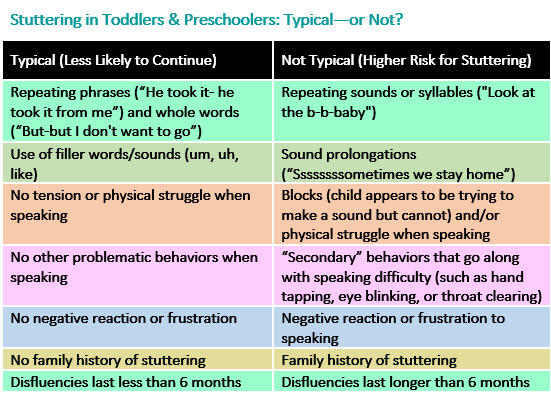As toddlers and preschoolers become increasingly verbal, they may begin to stumble over their words—raising concerns about stuttering. As a parent, how do you know when disfluencies are a normal part of development and when to be more concerned? Read on.
What are Typical Disfluencies?
It is not uncommon for young children to have disfluencies in their speech (e.g., word or phrase repetitions). In fact, about 5% of all children are likely to be disfluent at some point in their development, usually between ages 2 ½ and 5. It is also very typical for a child to go back and forth between periods of fluency and disfluency. Sometimes, this can occur for no apparent reason, but often this happens when a child is excited, tired, or feels rushed to speak.
Learning language rules:
During this time, children are expanding their vocabularies rapidly and learning complex language rules. These rules allow children to change simple messages (“Mommy juice”) into longer, more complicated sentences that require more motor coordination to produce smoothly (“Mommy put the juice in the blue cup”). It’s only natural that there may be some disruptions along the way.
Is It Truly Stuttering?
For most toddlers and preschoolers, most disfluencies go away on their own after a short period of time. In other cases, disfluencies persist and the signs of stuttering become more obvious. Getting professional help early offers the best chances for reducing stuttering. But how can parents tell the difference between typical disfluency that will go away and the early signs of non-typical disfluencies that may indicate stuttering?
Here are some ways to differentiate typical disfluency from stuttering:

If your child is truly stuttering, he or she may hold out the first sound in a word, saying “Ssssssssometimes we stay home,” or repeat the sound, as in “Look at the b-b-b-baby!” In addition, children who stutter often develop other mannerisms such as eye blinking, tense mouth, looking to the side, and avoiding eye contact.
Risk Factors for Stuttering:
There are other risk factors that can help predict whether fluency problems will continue for longer than a few months.
- Family history is the biggest predictor of whether a child is likely to stutter.
- Gender. Young boys are twice as likely as young girls to stutter, and elementary school-age boys are 3 to 4 times more likely to stutter than girls.
- Age of onset. Children that start having difficulties at age 4 are more likely to have a persistent stutter than those who begin stuttering at a younger age.
- Co-existing speech and/or language disorders increase the likelihood a child may stutter.
Getting Help:
If you are concerned about your child’s speech, talk with your pediatrician about getting a speech and language evaluation. A complete evaluation from a certified speech-language pathologist can help you to better determine if the stuttering is likely to persist.
Speech-language pathologists will help parents determine the best course of action (e.g., closely monitoring the child’s fluency, enrolling in treatment services, and/or parent education). The American Speech-Language-Hearing Association (ASHA) offers a searchable database of these professionals. In addition, a list of clinicians who specialize in stuttering can be found here.
Treatment Approaches for Stuttering:
Early treatment for stuttering is very important, as it is more likely to be eliminated when a child is young (before entering elementary school). There are two main treatment approaches for stuttering:
- Indirect treatment is when the speech-language pathologist helps the child’s parents on how to modify their own communication styles. Indirect approaches are effective at reducing or even eliminating stuttering in many young children.
- Direct treatment involves the speech-language pathologist working with the children themselves either one-on-one or in small groups, giving them specific speech strategies for easing into words and reducing tension during stuttering events. In addition, direct treatment may involve helping the child to differentiate between smooth (fluent) and bumpy (stuttered) speech.
After age 7, it becomes unlikely that stuttering will go away completely. Still, after age 7, treatment can be very effective at helping a child effectively manage stuttering—helping develop skills necessary to handle difficult situations (e.g., teasing and bullying) and participate fully in school and activities. For older children, speech treatment is still beneficial, encouraged, and effective in helping to reduce the severity and impact of stuttering.
What Parents Can Do:
Here are some ways parents can help:
- Reduce communication stress. There are different techniques to put less pressure on a child in a speaking situation. Rephrasing questions as comments (using “You played outside today at school. It must have been fun!” instead of “What did you do at school?”) is one effective approach. Parents can also do their best to reduce situations that trigger their child’s stuttering.
- Talk about it. When children are aware of their stuttering, it is best to be open and talk about it in a positive way. Let them know it is okay to have “bumpy speech.” If a child does not seem to be aware of the problem, there is no need to bring it up until you are seeing a speech-language pathologist.
- Practice patience. Give children time to finish what they are saying. Don’t rush or interrupt them. Don’t tell them to “slow down” or “think about what you want to say.” Phrases such as those are generally not helpful to children who stutter.
- Model good speech habits. While telling a child how to talk is generally not helpful, parents can model speech habits that help with stuttering, such as slowing down their own speed when they talk, putting in more pauses between sentences, and speaking in a relaxed manner.
- Seek a professional. There are many ways to find a speech-language pathologist. A child’s pediatrician can provide a recommendation. Children younger than 3 can receive a free evaluation through their local Early Intervention Program. If a child is older than 3, parents can contact their local public school for a free evaluation. Parents also have the option to seek out a private speech-language pathologist with a child at any age. A searchable database of these professionals is available here. A list of stuttering specialists is available here.
Follow Your Instincts:
If you continue to have concerns about your child’s speech, ask for a reevaluation or referral for additional formal testing.
Additional Information & Resources:
- Learn the Signs. Act Early (CDC.gov) – Aims to improve early identification of children with autism and other developmental disabilities so children and families can get the services and support they need.
- Stuttering (ASHA)
- Childhood Fluency Disorders (ASHA)
- National Stuttering Association
- Stuttering Foundation
